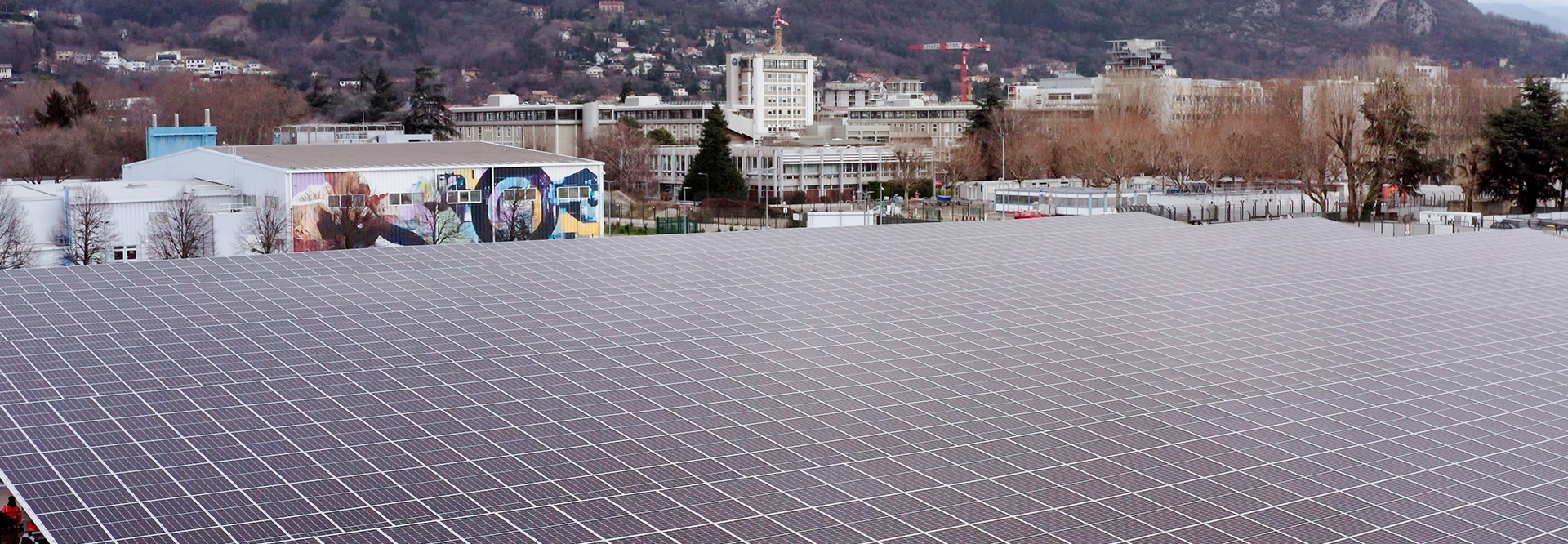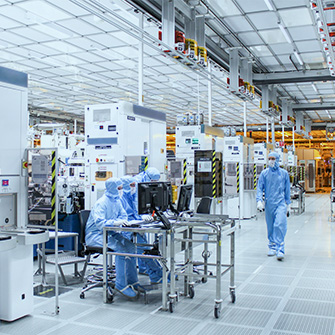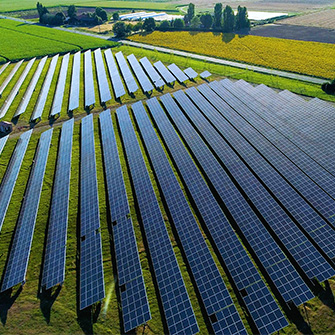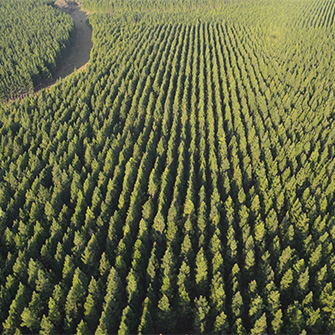Energy and climate change
We take action to mitigate the impact of our activities on climate change.
62%
renewable electricity
used
-40%
scope 1 & 2 emissions (since 2018)
2027
carbon neutrality commitment
by 2027
Climate change is one of the biggest threats facing society. At ST, we recognize we have a responsibility to help address this global challenge.
In 2020, we announced our commitment to becoming carbon neutral by 2027. Our carbon neutrality program includes:
- a comprehensive strategy covering the reduction of direct and indirect emissions, including product transportation, business travel, and employee commuting
- the sourcing of 100% renewable energy by 2027
- an intermediate milestone, to be achieved by 2025, with full compliance with the 1.5°C scenario defined in the Paris Agreement adopted at COP21, endorsed by the Science Based Targets Initiative (SBTi)
Moving towards carbon neutrality
Our carbon neutrality program comprises five main workstreams. I 3-3 I

The programs in place in all our manufacturing sites address our direct and indirect emissions in accordance with scopes 1, 2 and partly 3 of the GHG Protocol. In 2022, we decreased our CO2 equivalent emissions by 59% (per unit of production) compared to 2016.
Breakdown of GHG emissions l 305-1 l 305-2 l 305-3 l
Reducing our direct emissions
Our direct emissions, as defined by scope 1 of the Greenhouse Gas (GHG) Protocol, represent more than 50% of our total GHG emissions. In 2022, our direct emissions (measured in tons CO2 equivalent) increased by 5% in absolute terms, but we reduced our direct emissions per unit of production by 1% compared to 2021. The increase in direct emissions was mainly due to a rise in production volumes, as well as delays in the delivery and installation of abatement systems.
The use of perfluorinated compounds (PFCs) in the manufacture of semiconductors accounts for a significant proportion of our direct air emissions. It is therefore a central part of our environmental strategy to reduce their use and ensure they are treated appropriately before being released into the atmosphere. As part of our carbon neutrality journey, all our sites have invested in initiatives to reduce their direct emissions. Our Ang Mo Kio site (Singapore), one of the highest contributors to our total GHG emissions, installed 12 additional abatement systems to reduce PFCs. This resulted in a 4.7% reduction in PFC emissions per unit of production compared to 2021. Our Crolles (France) and Agrate (Italy) sites also installed additional abatement systems during 2022.
Investing in energy saving
In 2022, we decreased our energy consumption (per unit of production) by 19.8% compared to 2016, in line with our 2025 goal of a 20% reduction. However, there was an increase in our absolute energy consumption (+5%), due to a significant increase in production. Overall, this demonstrates the positive impact and efficiency of our actions.
All our manufacturing sites develop initiatives to optimize their energy consumption. Environment, health and safety (EHS) teams at our major sites worked on 45 projects during 2022, saving an additional 24GWh of energy. Since 2018, we have invested around US$42 million in energy-saving programs which have saved approximatively 112GWh of energy per year. This is in line with our objective to save at least 150GWh per year by 2027. l 302-4 l
Energy-saving projects we have implemented include the upgrade of point-of-use chillers and dry pumps at our Ang Mo Kio site (Singapore), saving more than 3.7GWh/year, and the installation of new free cooling systems in our Catania site (Italy), with an estimated saving of 4GWh/year.
Energy-saving initiatives are not exclusive to our manufacturing sites. To maximize our impact, we have engaged the entire organization in our carbon neutrality journey.
Our IT organization plays an important role by improving the energy efficiency of our service delivery. Allowing a higher temperature in data centers reduces the energy required for cooling. In addition, by using virtual server technology, we can reduce the number of physical servers – and therefore power consumption – required for the same amount of work. We estimate these actions save approximately 10.2GWh/year.
In France and Italy, we have created specific committees dedicated to energy management.
Focus
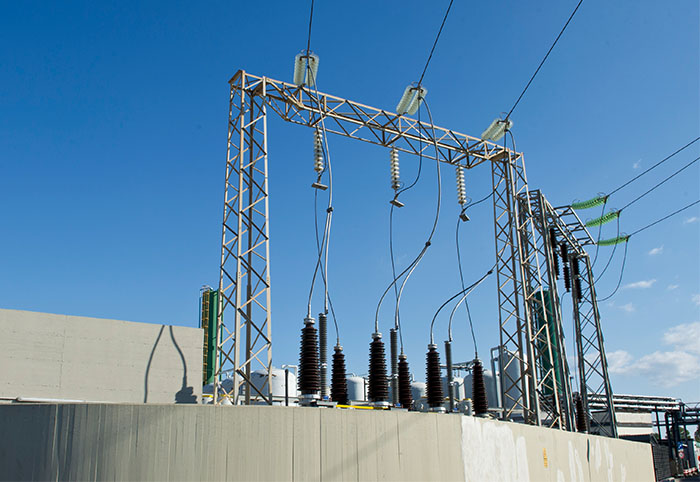
Energy efficiency
Reducing energy consumption is part of our goal to be a carbon neutral company by 2027. As part of our response to the energy crisis of 2022, we accelerated our energy-saving measures across the Company. We established energy crisis teams in France and Italy to drive short- and medium-term energy reduction programs at all sites. The committees are responsible for implementing the programs and monitoring performance to ensure manufacturing activities can continue in case of power rationing or cuts during winter.
Energy efficiency activities at each site are based around three key pillars.
- Cleanrooms: current programs are being stepped up wherever possible.
- Office spaces: temperature control; switching off lights, office equipment, drinks dispensers, and neon signs in the evening and at weekends; accelerated deployment of LED lighting. IT measures include temperature optimization of computer rooms and the use of energy-efficient equipment.
- Continuity plans in collaboration with national and local stakeholders, notably utility companies, electricity grid management, and public authorities.
All these actions help to mitigate the impacts of the energy crisis and accelerate our energy-saving programs, in line with our carbon neutrality objectives.
Using renewable energies
62%
renewable electricity
Almost 92% of the energy we use comes from electricity. Renewable sources provided 62% of the electricity we purchased in 2022, compared to 51% in 2021. Green sourcing helped us reduce our emissions by the equivalent of 464,624 metric tons of CO2, corresponding to 464,624 individual one way flights from Milan to New York. This is mainly due to purchasing more green electricity certificates.
Renewable electricity(1) (%) I 302-1 I
As part of the move towards more renewable energy sourcing, our Bouskoura site (Morocco) benefited from the electricity produced by 12 wind turbines installed in the framework of a power purchase agreement (PPA). In 2022, these turbines supplied 56% of the power used by the site, contributing to a reduction in CO2 emissions of about 31,500 metric tons.
The site also extended its 4,000m2 photovoltaic carport. An additional 3,100m2 of solar panels will supply approximately 0.9GWh of electricity from 2023. This will complement the 1GWh already supplied annually, which partially powers the site’s cleanroom.
Similarly, solar power installations at our sites in Catania (Italy) and Grenoble (France) produce 2GWh of green electricity annually. Our Grenoble site also installed a new photovoltaic carport during the year. The 10,900m2 of solar panels will produce 2.7GWh of electricity annually, from 2023.
Solar and wind PPAs will play a major role in our transition to 100% renewable electricity by 2027. Cross-functional teams have been working throughout the year on an ST energy procurement strategy. Our ambition is to identify new-build project opportunities which meet ‘additionality’ criteria. This means selecting projects that bring new capacity into the grids in locations where we operate. To achieve this, we will initiate strategic and long-term partnerships.

Marie Thorax
Energy Procurement Manager, EMEA
As part of our transition towards renewable energy, I am expanding our EMEA green energy supply with long-term procurement contracts. These will support the development of new renewable energy assets, such as wind farms and solar parks, and inject additional renewable electricity into the grid. In terms of carbon offsetting, we are building a strategy that focuses on promoting high-quality projects with robust methodologies and reliable funding. It is an exciting journey to be part of ST’s contribution to global efforts to combat climate change."
Minimizing our indirect emissions from transportation
From 15 material topics defined in scope 3 of the GHG Protocol, we have selected three areas to report where we can maximize our impact:
- employee commuting
- business travel
- goods transportation
The COVID-19 pandemic affected our scope 3 emissions for 2 years, making it difficult to report linear progression. In 2022, we noted a 22% increase compared to 2021. Emissions due to goods transportation, which represent 51% of our scope 3 emissions, increased by 19% during 2022. This was partly due to growth in our business and higher production volumes. The post-pandemic return to business travel and employee commuting also contributed to this increase.
However, compared with pre-pandemic figures (2019), in 2022 we saw a decrease of 50% in emissions related to business travel and 13% in emissions related to employee commuting, despite a headcount increase.
Our sites reinforced sustainable employee commuting concepts, promoting green transportation and car sharing. The deployment of flexible working arrangements, such as working from home, also helps to minimize our emissions. l 305-3 l
Offset remaining emissions
Our current environmental programs and data do not include carbon offsetting projects. Developing carbon offset programs is the final step of our carbon neutrality program.
In 2022, we created our vision for a balanced portfolio of offset projects, based on a long-term commitment to local projects and innovative solutions. Our criteria will focus on the quality of the carbon credit certificates generated. The objective is to combine nature-based solutions with technology solutions, for both carbon removal and avoidance. We will select and develop these projects in the coming years in collaboration with our stakeholders, according to local opportunities and needs.
Addressing climate-related risks
Since 2020, when we publicly declared our support for the Taskforce on Climate-related Disclosure (TCFD), we have been working towards implementing TCFD recommendations (see also Risk management and TCFD index).
We adopt a ‘double materiality’ perspective when considering climate-related risks:
- impact of our activities on the environment and people
- impact of climate change on our activities
In 2022, our environmental and resilience teams continued to work closely together to address physical risks resulting from climate change that are either chronic (induced by longer-term shifts in climate patterns) or acute (event-driven) in a way that is consistent with the TCFD and the EU Green Deal classification. This is illustrated in the table below.
|
Temperature-related |
Wind-related |
Water-related |
Solid mass-related |
||
|---|---|---|---|---|---|---|
Chronic |
Changing temperature (air, freshwater, marine water) |
Changing wind patterns |
Changing precipitation patterns and types (rain, hail, snow/ice) |
Coastal erosion |
||
Heat stress |
|
Precipitation or hydrological variability |
Soil degradation |
|||
Temperature variability |
|
Ocean acidification |
Soil erosion |
|||
Permafrost thawing |
|
Saline intrusion |
Solifluction |
|||
|
|
Sea level rise |
|
|||
|
|
Water stress |
|
|||
Acute |
Heat wave |
Cyclone, hurricane, typhoon |
Drought |
Avalanche |
||
Cold wave/frost |
Storm (including blizzards, dust and sandstorms), including medicanes |
Heavy precipitation (rain, hail, snow/ice) |
Landslide (including rock fall) |
|||
Wildfire |
Tornado |
Flood (coastal, fluvial, pluvial, groundwater) |
Subsidence |
|||
|
|
Glacial lake |
|
|||
|
|
|
|
|
||
|
Covered by climate change study |
Covered by specific site studies when required |
||||
|
Covered by water scarcity study |
Non-applicable to ST footprint |
||||
|
||||||
In 2021, we commissioned a science-based study from AXA Climate to assess current and future climate risks on our 140 most critical locations (ST and partner sites in 23 countries). To guide our adaptation efforts, the analysis was based on two climate change scenarios defined by the United Nations Intergovernmental Panel on Climate Change (IPCC):
- RCP4.5 (+2.4°C by 2100 vs pre-industrial levels)
- RCP8.5 (+4.3°C by 2100 vs pre-industrial levels)
For each scenario and location, climate projections for 2030 and 2050 show the likely impacts across a range of indicators, such as number of days of heatwaves, high winds, and heavy rain. This allows us to calculate a combined climate-related ‘peril score’ for each location.
Also in 2021, we commissioned a second study from Quantis, an environmental consultancy, focusing on the characteristics and impact of water scarcity and our carbon footprint (see Water).
In addition to these global analyses, we also carry out site-specific studies on natural hazards, according to local conditions.
Overall, the purpose of these various climate-related analyses is to inform our site-level business interruption risk assessments and business impact analyses, as well as our site resilience index. Ultimately, they feed into our regularly updated improvement, mitigation, and adaptation plans, helping us address environmental and resilience issues in the medium to long term.
We are proactively addressing the transition to a lower-carbon economy. In this context, we are in the process of further identifying and assessing policy, legal, technology, and market transition risks, across the short, medium and long terms, as per TCFD provisions. At the same time, we are actively investing in developing and launching new products to help our customers implement new energy-saving applications, transforming risk into opportunity (see Sustainable technology and Innovation).
Progress towards SBTi validated targets
As part of our carbon neutrality program, ST joined SBTi at the end of 2020. This initiative provides a clearly defined pathway for companies to reduce their GHG emissions. We were the first semiconductor company with approved targets to limit warming to no more than 1.5°C.
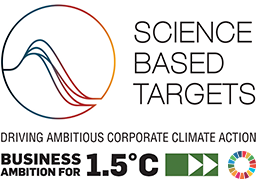
Our SBTi approved targets related to 1.5°C compliance are intermediate targets within our carbon neutrality commitment:
- 50% reduction of direct (scope 1) and indirect (scope 2) emissions by 2025 compared to 2018
- 80% renewable electricity sourcing by 2025
By the end of 2022, we were on track towards these targets, achieving 40% and 62% respectively.
|
2018 |
2019 |
2020 |
2021 |
2022 |
||||||
|---|---|---|---|---|---|---|---|---|---|---|---|
Direct emissions Scope 1 (KTons) |
692 |
560 |
489 |
484 |
507 |
||||||
Indirect emissions (purchased electricity) Scope 2 market-based(3) (KTons) |
772 |
707 |
567 |
474 |
360 |
||||||
Total emissions Scopes 1, 2 |
1,464 |
1,266 |
1,055 |
958 |
867 |
||||||
Renewable electricity/purchased electricity (%) |
23.1% |
30.0% |
43.0% |
50.9% |
62.0% |
||||||
|
|||||||||||
Contributing to the Sustainable Development Goals
Our commitments and programs as described above contribute to:
SDG target 7.3 – By 2030, double the global rate of improvement in energy efficiency.
SDG target 8.4 – Improve progressively, through 2030, global resource efficiency in consumption and production.
SDG target 13.1 – Strengthen resilience and adaptive capacity to climate-related hazards and natural disasters in all countries.
2027 sustainability goal |
Status |
Comments |
SG9: Be carbon neutral by 2027 in all direct and indirect emissions from scope 1 and 2, and focusing on product transportation, business travel and employee commuting emissions for scope 3. |
972KT net CO2 eq emissions |
|
SG10: Adopt 100% renewable energy sources by 2027 through energy procurement and green energy installations. |
57% of total energy |
|
SG11: Implement programs to reduce energy consumption by at least 150GWh per year by 2027. |
24GWh saved in 2022 |
2025 sustainability goal |
Status |
Comments |
SG12: Reduce energy consumption per wafer by 20% in 2025 vs 2016. |
-20% |
|
80% of renewable electricity by 2025. |
62% |
|
-50% absolute Scope 1 and Scope 2 GHG emissions by 2025 (2018 baseline). |
-40% |


